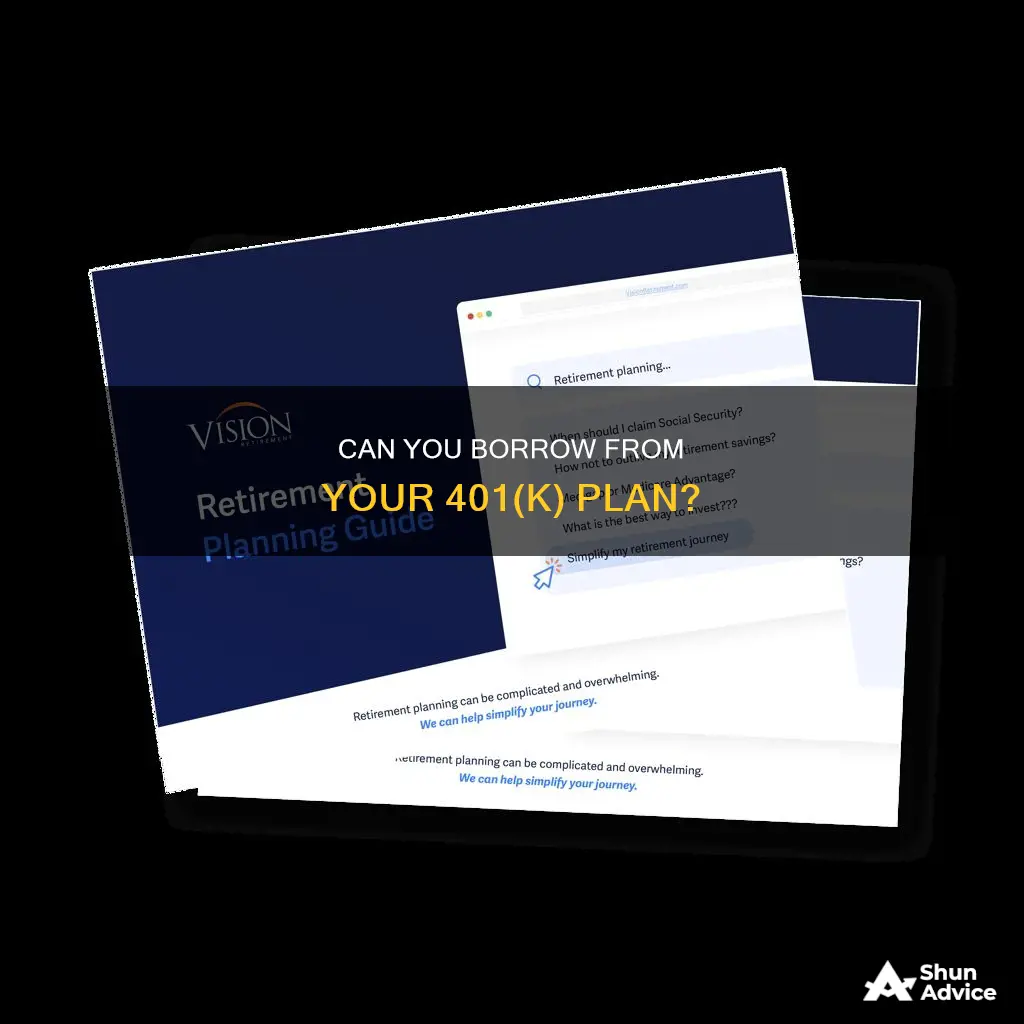
Principal offers retirement plans for startup companies with fewer than 100 employees. The Simply Retirement by Principal® 401(k) plan allows employees to be automatically enrolled at a default pre-tax contribution percentage. If permitted by the plan, employees can take out a loan from their 401(k) savings. However, it is important to consider the potential impacts of taking a loan from your retirement savings, such as losing out on potential earnings and growth in your retirement savings.
| Characteristics | Values |
|---|---|
| Company | Principal Finance |
| Product | Simply Retirement by Principal® |
| Product Description | A product for startup plans with fewer than 100 employees |
| Loan Availability | Yes, if permitted by your plan |
| Loan Amount | Typically a $50,000 max or 50% of your account within a 12-month period |
| Repayment Schedule | No longer than five years |
| Early Repayment | Consult your employer or HR department |
| Hardship Withdrawals | Yes |
| Interest and Fees | Applicable |
| Impact on Investment | Loss of potential earnings |
What You'll Learn

Borrowing money from your retirement savings
If you are considering a 401(k) loan, it is important to know the limits and repayment terms. Typically, you can borrow up to $50,000 or 50% of your vested account balance, whichever is less. An exception to this limit is if 50% of the balance is less than $10,000, in which case you may borrow up to $10,000. You will need to pay back the borrowed money, plus interest, within five years in most cases. Additionally, if you leave your job, you must repay the loan within 60 days or face a 10% penalty if you are under a certain age. It is worth noting that the money you borrow will no longer earn compound interest, impacting your retirement savings' potential growth.
Before taking out a 401(k) loan, it is recommended to explore all alternative options. Borrowing from your retirement savings should be a last resort. Consult with a financial planner to determine if there are better alternatives, such as loans from financial institutions or other sources. Consider the purpose of the loan and its true cost, including the loss of tax-deferred growth on investment returns.
If you decide to proceed with a 401(k) loan, be sure to understand the process and any specific rules set by your retirement plan. You may need to submit a request and review your available loan amounts and withdrawal options. Additionally, certain plans may require consent from your spouse or domestic partner for you to take out a loan. Keep in mind that while a 401(k) loan can provide quick access to cash, it may disrupt your long-term savings goals and retirement plans.
Prime Lending: Selling Loans and Mortgage Deals
You may want to see also

401(k) loan limits
A 401(k) loan borrows funds from a retirement account. It is important to note that loans are not permitted from IRAs or IRA-based plans. A 401(k) loan is only possible from qualified plans that satisfy the requirements of 401(a), from annuity plans that satisfy the requirements of 403(a) or 403(b), and from governmental plans.
There are set 401(k) loan limits and repayment requirements. The IRS 401(k) loan limits allow you to borrow up to $10,000 or 50% of your vested account balance, whichever is higher, with a maximum loan amount of $50,000. This maximum loan amount is typically within a 12-month period. If you take out more than one loan during this period, the maximum combined outstanding loan limit may be lower than $50,000.
The loan must be repaid within five years, unless the proceeds are used to purchase a primary residence. In the case of purchasing a primary residence, participants may repay the loan for up to 30 years. If you leave your job, you must repay the loan, typically within 60 days, or face a 10% penalty if you are under the age of 59 1/2.
Loans are not taxable distributions unless they fail to satisfy the plan loan rules with respect to amount, duration, and repayment terms. A loan that is not paid back according to the repayment terms is treated as a distribution from the plan and is taxable as such. A deemed distribution is treated as an actual distribution for the purpose of determining the tax on the distribution, including any early distribution tax.
It is important to consult with a financial planner before deciding to take a loan from your retirement account to ensure it is the best option for your financial situation.
Principal's Influence: Loan Approval's Unseen Factor
You may want to see also

Early repayment
A 401(k) loan allows you to borrow from your retirement savings and select a loan repayment schedule that suits you, typically with a maximum duration of five years. While you can repay a 401(k) loan early, there are several considerations to keep in mind. Firstly, not all 401(k) plans are created equal; some might charge a prepayment penalty for early repayment, so understanding your specific plan's rules is crucial. Secondly, early repayment of a 401(k) loan can strain your cash flow, so ensure that it doesn't leave you short on cash for essential expenses or emergency savings.
If you're considering early repayment of a 401(k) loan, here are some detailed steps to guide you through the process:
Understand Your Plan's Rules:
Before deciding on early repayment, carefully review your 401(k) plan's rules. Some plans might allow prepayments, while others may have restrictions. Check for any prepayment penalties or specific requirements, such as lump-sum payments or increased periodic payments. Contact your plan administrator to clarify these details and structure your additional payments effectively.
Calculate the Total Payoff Amount:
Request the total payoff amount for your loan from your plan administrator. This amount includes the remaining principal you owe, as well as any accrued interest up until the payoff date. Having a clear understanding of the total payoff amount is essential for your financial planning and ensuring you have sufficient funds to make the prepayment.
Make the Payment:
Once you've determined the precise payoff amount, you're ready to make the payment. When doing so, ensure that the payment is correctly applied towards reducing the principal of your loan, effectively lowering your outstanding balance. Accuracy is critical during this step.
Manage Your Cash Flow:
Explore Alternative Options:
If early repayment of a 401(k) loan doesn't align with your financial needs or long-term plans, there are alternative borrowing options to consider. These include using personal savings, securing a personal loan, or utilising a credit card. Each option has its own merits and drawbacks, so evaluate them carefully in the context of your financial situation and goals.
Remember, navigating a 401(k) loan requires a comprehensive understanding of its terms, including payment schedules, interest rates, and potential prepayment penalties. By making informed decisions, you can maximise the growth of your 401(k) and minimise financial stress.
Prequalification: A Loan Guarantee or Just a First Step?
You may want to see also

Hardship withdrawals
A hardship withdrawal is a permanent reduction in your retirement savings. While there are no penalties, you will pay income taxes on the distribution. Emergency withdrawals are relatively new—they were enacted as part of the SECURE Act 2.0 of 2022—and are another way to take money out of a 401(k). They, too, have specific conditions and limitations. Not every 401(k) plan includes an emergency withdrawal option.
If you have an employer-sponsored retirement plan such as a 401(k), you can check if your plan allows you to take money out in the form of a loan or withdrawal. Log in to your account and on your dashboard, click on the box for your 401(k) account.
If you are considering a hardship withdrawal, it is important to understand the impacts and, eventually, think about how to rebuild your savings. One way to build up your retirement savings without taking more from your paycheck is to save enough to get the full employer match.
If you need or want to withdraw funds before the age of 59 1/2, this is called an early withdrawal, and you may have to pay a penalty. The IRS has established 59 1/2 as the age when you may begin withdrawing, penalty-free, from both IRAs and a 401(k), if allowed by your plan.
Prime Choice Funding: No-Fuss No-Income Verification Loans
You may want to see also

Interest rates and fees
The interest portion of the loan payment is credited back to the borrower's 401(k) account. This means that the cost of borrowing from a 401(k) plan is lower than the cost of a typical loan. However, it is important to note that there may be modest loan origination or administration fees associated with a 401(k) loan.
In addition to interest rates and fees, there are tax implications to consider when taking out a 401(k) loan. The loan repayments are made with after-tax income, and the 401(k) will be taxed again when funds are withdrawn during retirement. This double taxation can have a significant impact on the overall cost of the loan. If the loan defaults, the borrower must pay income tax on the remaining balance, and the money cannot be returned to a retirement plan.
Compared to a 401(k) loan, a personal loan may offer a more attractive interest rate, especially for individuals with a high credit score. For example, with a credit score above 720, it may be possible to obtain a 10% interest rate on a personal loan. However, it is important to consider the impact of loan type on the appreciation of the 401(k) plan. Taking a 401(k) loan interrupts the ability to earn compound interest on retirement savings, which can hinder the growth of the retirement nest egg.
While a 401(k) loan does not incur immediate taxes and penalties, there are consequences if the loan is not repaid within the specified timeframe, typically five years. If the borrower leaves their job, they must repay the loan within a short period, usually 60 days, to avoid a 10% penalty if they are under the age of 59 1/2. Additionally, the money borrowed from the 401(k) plan is no longer contributing to the potential growth of the retirement savings. Therefore, it is advisable to consider a 401(k) loan only when no other reasonable loan rates are available and only in cases of genuine financial hardship.
Frequently asked questions
Some retirement plans may allow you to borrow money from your retirement savings through a loan. Principal Finance, for example, offers 401k loans. However, it is important to note that your retirement savings are intended for long-term savings, and taking a loan may cause you to lose out on potential earnings.
To find out if a plan loan is available to you, log in to your online account or talk to your human resources representative.
Loan repayments are made via after-tax payroll deductions. If you are working with a TPA, the plan may vary.







